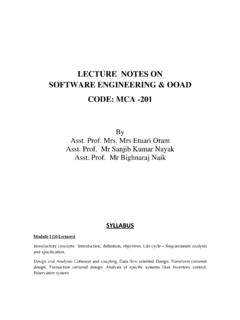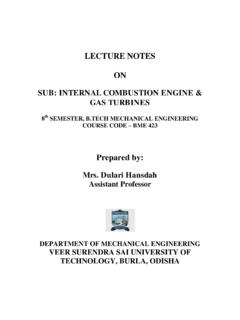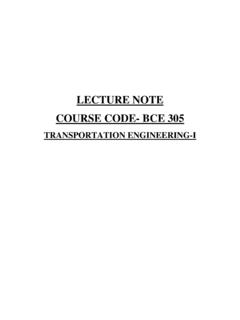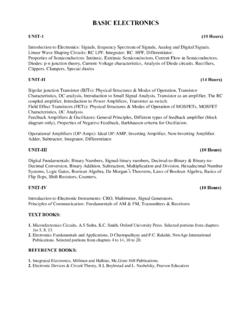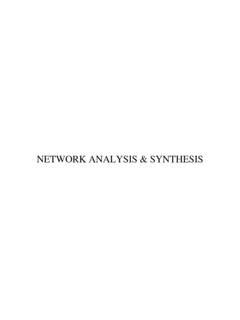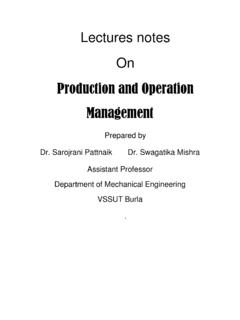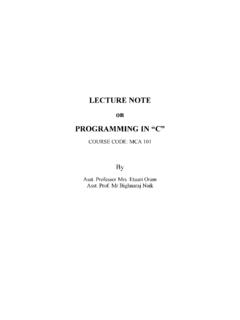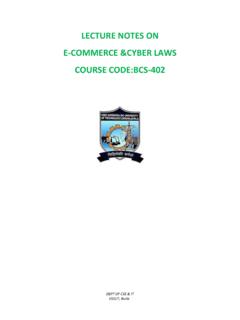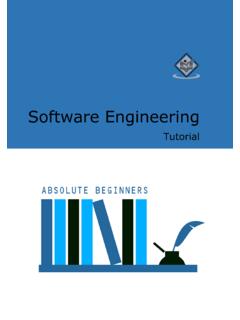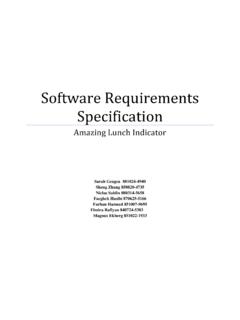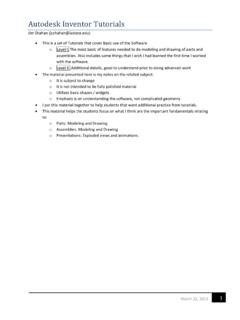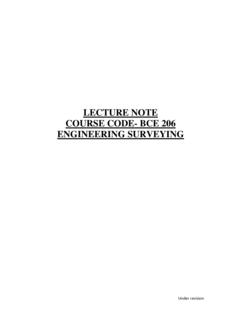Transcription of Software engineering notes - VSSUT
1 LECTURE notes ON Software engineering & OOAD CODE: MCA -201 By Asst. Prof. Mrs. Mrs Etuari Oram Asst. Prof. Mr Sanjib Kumar Nayak Asst. Prof. Mr Bighnaraj Naik SYLLABUS Module I (10 Lectures) Introductory concepts: Introduction, definition, objectives, Life cycle Requirements analysis and specification. Design and Analysis: Cohesion and coupling, Data flow oriented Design: Transform centered design, Transaction centered design. Analysis of specific systems likes Inventory control, Reservation system. 2 *Under revision Module II (10 Lectures) Object&oriented Design: Object modeling using UML, use case diagram, class diagram, interaction diagrams: activity diagram, unified development process.
2 Module III (10 Lectures) Implementing and Testing: Programming language characteristics, fundamentals, languages, classes, coding style efficiency. Testing: Objectives, black box and white box testing, various testing strategies, Art of debugging. Maintenance, Reliability and Availability: Maintenance: Characteristics, controlling factors, maintenance tasks, side effects, preventive maintenance Re engineering Reverse engineering configuration management Maintenance tools and techniques. Reliability: Concepts, Errors, Faults, Repair and availability, reliability and availability models, Recent trends and developments. Module IV (10 Lectures) Software quality: SEI CMM and ISO&9001. Software reliability and fault&tolerance, Software project planning, monitoring, and control.
3 Computer&aided Software engineering (CASE), Component model of Software development, Software reuse. Book: 1. Rajib Mall, Fundamentals of Software engineering , PHI. 2. Pressman, Software engineering Practitioner s Approach, TMH. 3. Pfleeger, Software engineering Theory and Practice, 2nd Edition, Pearson Education. 4. Shooman, Software engineering Design, Reliability and Management, McGraw Hill. Contents Module: I Lecture 1: Introduction to Software engineering Lecture 2: Definition & Principles of Sofware Engg., Software Characteristics Lecture 3: Causes & Solution of Software Crisis, Software Application and 3 *Under revision processes.
4 Lecture 4: Software Life Cycles Methods and Description of Classical Water fall Model. Lecture 5: Iterative water fall life cycle Model, Prototyping/Rapid Prototyping Model and Spiral Model Lecture 6: Software requirement & Specification Lecture 7: Complex Logic: Decision tree & Decision Table, Specification of Complex Logic. Lecture 8: Cohesion and Coupling Lecture 9: Data Flow Oriented Design Lecture 10: Transaction Analysis, Inventory Control System Module II Module III Module IV MODULE-I Lecture Note: 1 Software : Software is defined as a collection of programs, procedures, rules, data and associated documentation.
5 The s/w is developed keeping in mind certain h/w and operating system consideration commonly known as platform. And engineering means systematic procedure to develop Software . Some of the Software characteristics are, it 4 *Under revision can be engineer or developed and second thing is Software is complex in nature. Important of Software are due to much reason as it is used in: i)Business decision making Ex& accounting s/w, billing s/w ii)For scientific research & engineering problem solving. Ex&weather forecasting system, space research s/w iii)It is embedded in multifunctional systems such as medical, telecom entertainment etc.
6 Ex&s/w for medical patient automation, s/w of GSM/CDMA service provides. Software Quality Several quality factors associated with Software quality are as following: Portability: A Software product is said to be portable, if it can be easily made to work in different operating system environments, in different machines, with other Software products, etc. Usability: A Software product has good usability, if different categories of users ( both expert and novice users) can easily invoke the functions of the product. Reusability: A Software product has good reusability, if different modules of the product can easily be reused to develop new products. Correctness: A Software product is correct, if different requirements as specified in the SRS document have been correctly implemented.
7 Maintainability: A Software product is maintainable, if errors can be easily corrected, new functions can be easily added to the product, and the functionalities of the product can be easily modified, etc. Types of Software :- Computer s/w is mainly divided into two types. a)system s/w Application s/w consists of programs to perform user oriented tasks. System s/w includes the operating system & all the utilities to enable the computer to run. Ex&window operating system b)application s/w 5 *Under revision Application s/w consists of programs to perform user oriented tasks. Ex&word processor, database management.
8 Application s/w sits about the system s/w because it needs help of the system s/w to run. Program vs Software product PROGRAMS PRODUCTS Set of instruction related each other Collection of program designed for specific task. Programs are defined by individuals for their personal use. A sum product is usually developed by a group of engineers working as a team. Usually small size. Usually large size. Single user. Large no of users. Single developer. Team of developer. Lack proper documentation. Good documentation support. ADHOC development. Systematic development. Lack of UI. Good UI. Have limited functionality. Exhibit more functionality. Types of Software products: -Generic products: [This type of Software product are developed by a organization and sold on open market to any customer], (System Software ,, application Software ) Source code Object code programs documentation Operating procedure 6 *Under revision -Customized (or bespoke) products: This type of Software products are developed by a Software contractor and especially for a customer.
9 -Embedded Product: Combination of both hardware and Software Software engineering Application of engineering for development of Software is known as Software engineering . It is the systematic, innovative technique and cost effective approach to develop Software . And person involved in developing product is called Software engineer. S/w engineer is a licensed professional engineer who is skilled in engineering discipline. Qualities / Skills possessed by a good Software engineer: 1. General Skill (Analytical skill, Problem solving skill, Group work skill) 2. Programming Skill (Programming language , Data structure , Algorithm , Tools( Compiler, Debugger)) 3. Communication skill (Verbal , Written, Presentation) 4. Design Skill (s/w engineer must be familiar with several application domain) Lecture Note : 2 IEEE definition of Software engineering : A systematic, disciplined and quantifiable approach to the development, operation, maintenance and refinement of Software .
10 Factor in emergence of Software engineering : 7 *Under revision 1. People who are developing Software were consistently wrong in their estimation of time, effort and cost. 2. Reliability and maintainability was difficult of achieved 3. Fixing bug in a delivered Software was difficult 4. Delivered Software frequently didn t work 5. Changes in ration of hw to s/w cost 6. Increased cost of Software maintenance 7. Increased demand of Software 8. Increased demand for large and more complex Software system 9. Increasing size of Software S/W engineering PRINCIPLES:- Software engineering is a layered technology. The bedrock that supports Software engineering is a quality focus.

